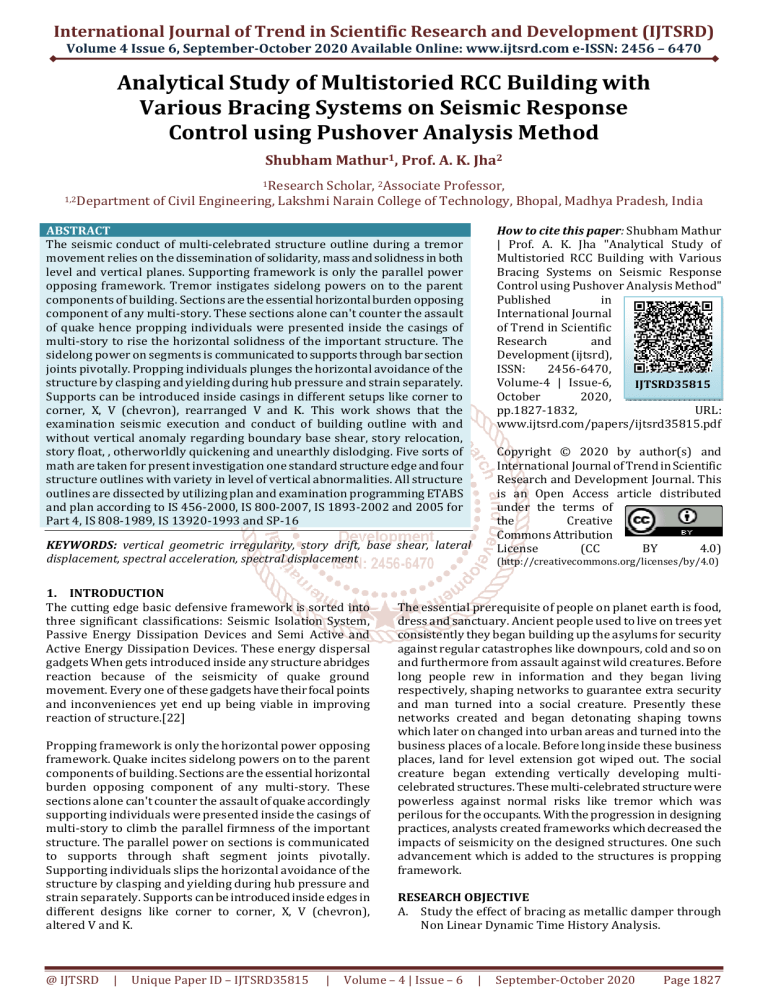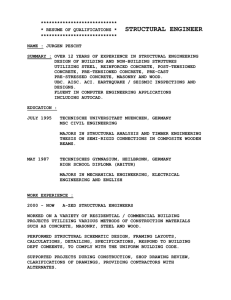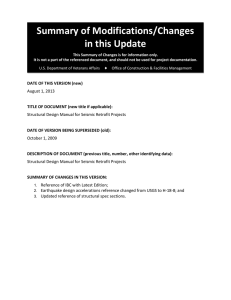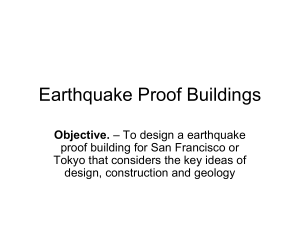
International Journal of Trend in Scientific Research and Development (IJTSRD)
Volume 4 Issue 6, September-October 2020 Available Online: www.ijtsrd.com e-ISSN: 2456 – 6470
Analytical Study of Multistoried RCC Building with
Various Bracing Systems on Seismic Response
Control using Pushover Analysis Method
Shubham Mathur1, Prof. A. K. Jha2
1Research
1,2Department
Scholar, 2Associate Professor,
of Civil Engineering, Lakshmi Narain College of Technology, Bhopal, Madhya Pradesh, India
ABSTRACT
The seismic conduct of multi-celebrated structure outline during a tremor
movement relies on the dissemination of solidarity, mass and solidness in both
level and vertical planes. Supporting framework is only the parallel power
opposing framework. Tremor instigates sidelong powers on to the parent
components of building. Sections are the essential horizontal burden opposing
component of any multi-story. These sections alone can't counter the assault
of quake hence propping individuals were presented inside the casings of
multi-story to rise the horizontal solidness of the important structure. The
sidelong power on segments is communicated to supports through bar section
joints pivotally. Propping individuals plunges the horizontal avoidance of the
structure by clasping and yielding during hub pressure and strain separately.
Supports can be introduced inside casings in different setups like corner to
corner, X, V (chevron), rearranged V and K. This work shows that the
examination seismic execution and conduct of building outline with and
without vertical anomaly regarding boundary base shear, story relocation,
story float, , otherworldly quickening and unearthly dislodging. Five sorts of
math are taken for present investigation one standard structure edge and four
structure outlines with variety in level of vertical abnormalities. All structure
outlines are dissected by utilizing plan and examination programming ETABS
and plan according to IS 456-2000, IS 800-2007, IS 1893-2002 and 2005 for
Part 4, IS 808-1989, IS 13920-1993 and SP-16
How to cite this paper: Shubham Mathur
| Prof. A. K. Jha "Analytical Study of
Multistoried RCC Building with Various
Bracing Systems on Seismic Response
Control using Pushover Analysis Method"
Published
in
International Journal
of Trend in Scientific
Research
and
Development (ijtsrd),
ISSN:
2456-6470,
Volume-4 | Issue-6,
IJTSRD35815
October
2020,
pp.1827-1832,
URL:
www.ijtsrd.com/papers/ijtsrd35815.pdf
Copyright © 2020 by author(s) and
International Journal of Trend in Scientific
Research and Development Journal. This
is an Open Access article distributed
under the terms of
the
Creative
Commons Attribution
License
(CC
BY
4.0)
KEYWORDS: vertical geometric irregularity, story drift, base shear, lateral
displacement, spectral acceleration, spectral displacement
1. INTRODUCTION
The cutting edge basic defensive framework is sorted into
three significant classifications: Seismic Isolation System,
Passive Energy Dissipation Devices and Semi Active and
Active Energy Dissipation Devices. These energy dispersal
gadgets When gets introduced inside any structure abridges
reaction because of the seismicity of quake ground
movement. Every one of these gadgets have their focal points
and inconveniences yet end up being viable in improving
reaction of structure.[22]
Propping framework is only the horizontal power opposing
framework. Quake incites sidelong powers on to the parent
components of building. Sections are the essential horizontal
burden opposing component of any multi-story. These
sections alone can't counter the assault of quake accordingly
supporting individuals were presented inside the casings of
multi-story to climb the parallel firmness of the important
structure. The parallel power on sections is communicated
to supports through shaft segment joints pivotally.
Supporting individuals slips the horizontal avoidance of the
structure by clasping and yielding during hub pressure and
strain separately. Supports can be introduced inside edges in
different designs like corner to corner, X, V (chevron),
altered V and K.
@ IJTSRD
|
Unique Paper ID – IJTSRD35815
|
(http://creativecommons.org/licenses/by/4.0)
The essential prerequisite of people on planet earth is food,
dress and sanctuary. Ancient people used to live on trees yet
consistently they began building up the asylums for security
against regular catastrophes like downpours, cold and so on
and furthermore from assault against wild creatures. Before
long people rew in information and they began living
respectively, shaping networks to guarantee extra security
and man turned into a social creature. Presently these
networks created and began detonating shaping towns
which later on changed into urban areas and turned into the
business places of a locale. Before long inside these business
places, land for level extension got wiped out. The social
creature began extending vertically developing multicelebrated structures. These multi-celebrated structure were
powerless against normal risks like tremor which was
perilous for the occupants. With the progression in designing
practices, analysts created frameworks which decreased the
impacts of seismicity on the designed structures. One such
advancement which is added to the structures is propping
framework.
RESEARCH OBJECTIVE
A. Study the effect of bracing as metallic damper through
Non Linear Dynamic Time History Analysis.
Volume – 4 | Issue – 6
|
September-October 2020
Page 1827
International Journal of Trend in Scientific Research and Development (IJTSRD) @ www.ijtsrd.com eISSN: 2456-6470
B. To study the response of building with and without
bracing system.
C. To verify whether the passive energy dissipation used
2. LITERATURE REVIEW
Montuori R. et al. 2018 [25] expected to explore the impact
of the supporting plan on the seismic exhibitions of Moment
Resisting Frames-Eccentrically Braced Frames (MRF-EBF)
double frameworks, planned by two plan draws near: the
first is the Theory of Plastic Mechanism Control (TPMC)
while the subsequent one depends on Euro code 8 (EC8)
plan arrangements. Despite the fact that TPMC configuration
approach isn't presented in current seismic codes, it has
procured the standing of being a vigorous plan approach due
to its solid hypothetical foundation, in light of the kinematic
hypothesis of plastic breakdown reached out to the
breakdown system balance bend to guarantee a breakdown
instrument of worldwide sort. On the other hand, the plan
approach dependent on EC8 advances the use of the alleged
pillar segment chain of command standard which is
generally ready to keep away from delicate story
instruments yet doesn't guarantee the yielding of the
apparent multitude of dissipative zones, in light of the fact
that a breakdown system of worldwide sort is seldom
accomplished. Their fundamental motivation behind work is
to analyze, given the previously mentioned plan draws near,
the diverse seismic exhibitions coming about because of the
utilization of the four distinctive propping plan proposed by
codes. Therefore, 5 sound structures with 4, 6 and 8 story's
have been inspected considering four supporting plans
giving an all-out number of 12 basic plans investigated. The
seismic exhibitions have been assessed by methods for
Incremental Dynamic Analyses (IDA) completed until the
accomplishment of auxiliary breakdown and rehashed for a
bunch of ten quake ground movement. Structures whose
supports are masterminded by the reversed Y conspire have
driven in all cases to the best seismic exhibitions; both on
account of structures planned by TPMC and if there should
arise an occurrence of EC8 configuration approach,
autonomously of the quantity of storey's. In examination
with the transformed Y-conspire, the ghostly speeding up
prompting the breakdown lessens on normal of about 10%,
20% and 35% if there should arise an occurrence of K-plot, D
plan and V-plot, separately. Specifically, if there should be an
occurrence of structures planned by TPMC the outcomes got
show that V-conspire structures consistently display the
most noticeably awful exhibitions autonomously of the
quantity of stories.
M. S. Speicher et al. 2019 [26] Developed a shape memory
compound (SMA) based explained quadrilateral (AQ)
supporting framework and tentatively tried for seismic
opposing applications. Framework gives both reappearing
and damping in a versatile plan. Driven by SMA's novel
capacity to recoup strains of up to around 8% through
dissemination less stage change, the foundation of the
propping proposed thus is the capacity to change the energy
dispersal in a returning hysteretic circle using an AQ game
plan. The verbalized quadrilateral plan gives an adaptable,
reconfigurable, advantageous methods for joining nickeltitanium (NiTi) wires and energy dispersing components.
This setup makes a framework with a customizable measure
of re-focusing and damping, which might be utilized in a
wide assortment of new and existing structures. For these
model tests, NiTi wire groups were joined with long C-
@ IJTSRD
|
Unique Paper ID – IJTSRD35815
|
molded dampers to make a framework with a decent
equilibrium of returning and energy dissemination. The
framework was exposed to cyclic stacking to evaluate the
conduct. The framework looked after quality, malleability,
and returning in the wake of being cycled to 2% float, which
is a commonplace greatest in basic frameworks if non-basic
components are to be saved. An investigative contextual
analysis exhibited that shape memory composite
frameworks will in general convey the distortion all the
more uniformly over the tallness of the structure contrasted
with conventional frameworks, which is an alluring seismic
presentation trademark. It is imagined that, by utilizing a
similar essential supporting arrangement, a wide scope of
power disfigurement reactions can be available to an
architect.
METHODOLOGY
Step1: Modeling of Building Frame
Step 2: Analysis
Each type of frame is analyzed separately by using push over
analysis method and time history analysis method by using
STAB 2000.
Step 3: Comparison of results
A. The result acting is compare in term of theory
displacement, theory drift shear force, bending moment
etc.
B. Review the existing literature.
C. Selection of model for the case study.
D. Modeling the selected structures in different seismic
zones 4.
E. Non Linear analysis of the selected structure model and
a comparative study on the results obtained from the
analysis.
F. Finally compare the result and observation
NEED OF STUDY
A. Normal building is not stable in earthquake forces.
B. Bracing system is more effective then metallic damper.
Modeling of Building Frame
Metallic braces is the easiest and simplest way of reducing
response of building which gave rise to five models for the
analysis
A. Model In - G7RCFWOBS : G+7 storey Reinforced
Concrete Frame Without Bracing System
B. Model II - G7RCFWIVBS: G+ 7 storey Reinforced
Concrete Frame with IV Bracing System.
C. Model III - G7RCFWXBS: G+ 7 storey Reinforced
Concrete Frame with X Bracing System.
D. Model IV - G7RCFWVBS: G+ 7 storey Reinforced
Concrete Frame with V Bracing System.
E. Model V- G7RCFWEBS : G+ 7 storey Reinforced Concrete
Frame with Eccentric Bracing System
Model I is bare frame model. Model II, III and IV include
inverted V (IV), X, V and Eccentric Braced Frame
configuration of concentric bracing system. This system of
bracing is used because eccentric bracing systems consist of
a link element that undergoes inelastic deformation for
energy dissipation. This link is possibly beam element of
frame structure which is more suitable for steel structures
and not for reinforced concrete structures.
Volume – 4 | Issue – 6
|
September-October 2020
Page 1828
International Journal of Trend in Scientific Research and Development (IJTSRD) @ www.ijtsrd.com eISSN: 2456-6470
Figure 1:-D SAP2000 Modeled Building
The above figure 2 shows G +7 Simple Building model In Sap2000. With beam size 300 X 400 mm and column size 400 X 500
mm this reinforced concrete building having M20 grade of Concrete and Fe415 high density steel. To study the response of
building with and without bracing system.
Figure 2: Sectional Properties of Beam
The above figure 3 shows Simple Beam cross section. With beam size 300 X 400 mm this reinforced concrete building having
M20 grade of Concrete and Fe415 high density steel.
Figure 3: Sectional Properties of Column
@ IJTSRD
|
Unique Paper ID – IJTSRD35815
|
Volume – 4 | Issue – 6
|
September-October 2020
Page 1829
International Journal of Trend in Scientific Research and Development (IJTSRD) @ www.ijtsrd.com eISSN: 2456-6470
The above figure4.4 shows Simple Column cross section. With Column size 400 X 500 mm this reinforced concrete building
having M20 grade of Concrete and Fe415 high density steel.
Assumed Data for Models
Building
= G + 7 Storey
Slab Thickness
=
120 mm
Live Load
=
3 kN/m2
Floor Finish
=
1 kN/m2
Concrete Grade
=
M20
Concrete Density
=
25 kN/m3
Steel Grade
=
Fe415
Steel Density
=
7850 kN/m3
Earthquake Used
=
North Ridge, Imperial Valley, Kern & North Ridge
DESIGN OF EXPERIMENTAL SET-UP & INSTRUMENTATION
SAP2000 models for bracings:
3-D and elevation view five models created are depicted in Figure 4.
Figure 4: 3-D and Elevation View of Bare Frame Structure
The above figure7.1 shows G+7 Simple Building model In Sap2000. With beam size 300 X 400 mm and column size 400 X 500
mm this reinforced concrete building having M20 grade of Concrete and Fe415 high density steel. This model noted as bare
frame for further notification. This modeled noted as G+ 7 storey’s Reinforced Concrete Frame without Bracing System
(G7RCFWOBS)
ANALYSIS OF RESULTS
Table compares the effect of bracing on displacement of each storey with bare frame for earthquake of four different
intensities.
Table: 1. Displacements occurred at various stories with different patterns of bracing for Imperial Valley Time
History
Displacements (mm)
Earthquake Time
Storey
Bare
EB Brace
IV Brace
X Brace
V Brace
History
No.
Frame
Frame
Frame
Frame
Frame
1
0.0
0.0
0.0
0.0
0.0
2
44.0
28.6
15.6
14.1
27.3
3
113.9
68.8
38.9
35.2
67.1
4
183.7
109.9
63.0
58.6
107.6
Imperial Valley
5
245.2
149.7
86.2
82.9
146.3
6
299.4
185.8
107.4
106.6
181.3
7
343.7
215.9
125.5
128.3
211.0
8
375.7
238.8
139.6
146.9
234.2
@ IJTSRD
|
Unique Paper ID – IJTSRD35815
|
Volume – 4 | Issue – 6
|
September-October 2020
Page 1830
International Journal of Trend in Scientific Research and Development (IJTSRD) @ www.ijtsrd.com eISSN: 2456-6470
Figure 5: Displacement comparison for bare frame and braced frame model for Imperial Valley earthquake
A comparison is made between shear force values of bare frame and different configuration of bracing utilized for four different
ground motion in Table 2. It becomes very essential to monitor the shear force magnitude in to justify whether braced element
not only reduce storey drift and displacement but also lower the level of demands on the lateral force resisting element.
Table: 2. Shear Force induced in columns of various stories with different patterns of bracing for Imperial Valley
Time History
Shear Force (kN)
Earthquake Time
Storey
Bare
EB Brace
IV Brace
X Brace
V Brace
History
No.
Frame
Frame
Frame
Frame
Frame
1
636.0
432.3
225.6
198.8
415.7
2
479.6
183.1
107.4
92.0
204.9
3
436.9
174.0
101.1
73.3
181.4
4
377.9
147.2
87.0
62.2
149.7
Imperial Valley
5
340.6
115.7
71.0
50.7
117.5
6
268.4
78.2
52.4
35.0
81.7
7
164.4
53.6
32.8
21.1
58.3
8
44.1
40.4
15.9
12.6
43.2
Figure 6: Shear Force comparison for bare frame and braced frame model for Imperial Valley earthquake
CONCLUSIONS
Through the Non Linear Dynamic Time History Analysis of
bare frame and braced frames led to the following
conclusions
@ IJTSRD
|
Unique Paper ID – IJTSRD35815
|
1.
An improvement in performance of structure was seen
through the fabrication of metallic bracings inside the
bare frame.
Volume – 4 | Issue – 6
|
September-October 2020
Page 1831
International Journal of Trend in Scientific Research and Development (IJTSRD) @ www.ijtsrd.com eISSN: 2456-6470
2.
3.
4.
5.
6.
7.
Metallic braces helped reducing the displacement at
each storey to about 40% averagely.
X and chevron braces were more effective as compared
to V and diagonal brace in controlling the storey
displacement.
The maximum amount of shear force was found in
bottom storey column and reduced for higher storey
column.
Metallic bracings helped in reducing the shear demands
on column members and was found least in case of X
and Chevron brace than V and diagonal brace.
The moment in columns also reduced effectively for X
and Chevron brace than V and diagonal brace which was
found to be maximum in bottom storey column.
The whole work concluded that the performance of
structure could be elevated through metallic bracings
which lowered the demands on the primary lateral loads
resisting members thereby safeguarding the elements.
REFERENCES
[1] Bahey S. E. andBruneau M. , "Clasping Restrained
Braces as Structural Fuses for the Seismic Retrofit of
Reinforced Concrete Bridge Bents", Engineering
Structures, Elsevier Science Direct, Vol. 33, pp. 1052 1061, 2011
[6]
Ghobarah A. , Elfath H. A. " Rehabilitation of a
strengthened solid edge utilizing flighty steel
supporting", Engineering Structures, Elsevier Science
Direct, 2001, Vol. 23, pp 745–755.
[7]
Hjelmstad K. D. also, Popov E. P. " Characteristics of
Eccentrically Braced Frames", Journal of Structural
Engineering,
American
Society
for
Civil
Engineering(ASCE), 1984, Vol. 110, No. 2, pp 340 353.
[8]
Khandelwal K., Tawil S. E., Sadek F. "Reformist
breakdown examination of seismically planned steel
propped outlines", Journal of Constructional Steel
Research, Elsevier Science Direct, 2009, Vol. 65, pp.
699-708.
[9]
Ma H. also, Yam C. H. , "Displaying of Self Centering
Damper and its Application in Structural Control",
Journal of Constructional Steel Research, Elsevier
Science Direct, Vol. 67, pp. 656 - 666, 2011
[10]
Maheri M. R. what's more, Sahebi A. " Use of steel
propping in fortified solid flares", Journal of
Engineering Structures, Elsevier Science Direct, 1997,
Vol. 19, No. 12, pp. 1018-1024.
[11]
Moghaddam H., Hajirasouliah I. and Doostan A. , "Ideal
Seismic Design of Concentrically Braced Steel Frames:
Concepts and Design Procedures", Journal of
Constructional Steel Research, Elsevier Science Direct,
Vol. 61, pp. 151 - 166, 2005
[2]
Brunesi E., Nascimbene R., Casagrande L. "Seismic
examination of tall building uber propped outline
center structures", Journal of Engineering Structures,
Elsevier Science Direct, 2016, Vol.115, pp. 1–17.
[3]
Chou C. C., Chung P. T, Cheng Y. T. "Exploratory
assessment of enormous scope double center selffocusing supports and sandwiched clasping limited
supports", Journal of Engineering Structures, Elsevier
Science Direct, 2016, Vol.116, pp. 12–25.
[12]
Moghaddam H., Hajirasouliha I., Doostan A. "Ideal
seismic plan of concentrically propped steel outlines:
ideas and plan strategies", Journal of Constructional
Steel Research, Elsevier Science Direct, 2005, Vol. 61,
pp. 151–166.
[4]
Douglas A. Foutch "Seismic Behavior of Eccentrically
Braced Steel structures", Journal of Structural
Engineering,
American
Society
for
Civil
Engineering(ASCE), 1989, Vol. 115, No. 8, pp 18571876.
[13]
Montuori R., Nastri E. Piluso V. "Impact of the bracing
scheme on seismic exhibitions of MRF-EBF double
frameworks", Journal of Constructional Steel
Research, Elsevier Science Direct, 2018, Vol. 132, pp.
179 - 190.
[5]
Gabroah A. also, Elfath H. A., "Recovery of Reinforced
Concrete Frame Using Eccentric Steel Bracing",
Engineering Structures, Elsevier Science Direct, Vol.
23, pp. 745 - 755, 2001.
[14]
Ozel A. E., Guneyisi E. M. "Impacts of unpredictable
steel propping frameworks on seismic delicacy bends
of mid-ascent R/C structures: A contextual
investigation", Journal of Structural Safety, Elsevier
Science Direct, 2011, Vol.33, pp. 82–95.
@ IJTSRD
|
Unique Paper ID – IJTSRD35815
|
Volume – 4 | Issue – 6
|
September-October 2020
Page 1832





